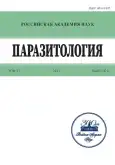Реконструкция строения мирацидия Derogenes varicus (Digenea: Derogenidae): первое ультраструктурное описание шипов на поверхности личинок Hemiurata
- Авторы: Смирнов П.А1,2, Крупенко Д.Ю2
-
Учреждения:
- Зоологический институт РАН
- Санкт-Петербургский государственный университет
- Выпуск: Том 57, № 2 (2023)
- Страницы: 108-123
- Раздел: Статьи
- URL: https://journal-vniispk.ru/0031-1847/article/view/145446
- DOI: https://doi.org/10.31857/S0031184723020023
- EDN: https://elibrary.ru/AZWGWF
- ID: 145446
Цитировать
Полный текст
Аннотация
Ключевые слова
Об авторах
П. А Смирнов
Зоологический институт РАН;Санкт-Петербургский государственный университет
Email: smirnov_pa@rambler.ru
Д. Ю Крупенко
Санкт-Петербургский государственный университет
Список литературы
- Семёнов О.Ю. 1991. Мирацидии: строение, биология, взаимодействие моллюсками. Тр. ЛОЕ 83 (4): 203 с.
- Semenov O.Y. 1991. Miracidia: structure, biology, inter-relationships with molluscs. Tr. LOE 83 (4): 203 pp. (in Russian).
- Тихомиров И.А. 2000. Микроанатомия мирацидия Philophthalmus rhionica (Trematoda: Philophthalmidae). Паразитология 34 (3): 210-221.
- Tikhomirov I.A. 2000. Microanatomy of Philophthalmus rhionica miracidium (Trematoda: Philophthalmidae). Parasitologiya 34 (3): 210-221. (in Russian).
- Anderson M.G., Anderson F.M. 1963. Life history of Proterometra dickermani Anderson, 1962. The Journal of Parasitology 49 (2): 275-280. https://doi.org/10.2307/3275994
- Baylis H.A. 1938. On two species of the trematode genus Didymozoon from the mackerel. Journal of the Marine Biological Association of the United Kingdom 22 (2): 485-492. https://doi.org/10.1017/S0025315400012388
- Brooks D.R., O'Grady R.T., Glen D.R. 1985. Phylogenetic analysis of the Digenea (Platyhelminthes: Cercomeria) with comments on their adaptive radiation. Canadian Journal of Zoology 63 (2): 411-443.
- Galaktionov K.V., Dobrovolskij A.A. 2003. The biology and evolution of trematodes: an essay on the biology, morphology, life cycles, transmissions, and evolution of digenetic trematodes. Springer Science & Business Media.
- Gibson D.I., Bray R.A. 1979. The Hemiuroidea: terminology, systematics and evolution. Bulletin of the British Museum 36: 35-146. https://doi.org/10.5962/bhl.part.3604
- Hussey K.L. 1945. The miracidium of Proterometra macrostoma (Faust) Horsfall 1933. The Journal of Parasitology 31 (4): 269-271.
- Looss A. 1894. Die Distomen unserer Fische und Frösche: Neue Untersuchungen über Bau und Entwickelung des Distomenkörpers. Bibliotheca Zoologica 6 (16): 1-296.
- Madhavi R. 1978. Life history of Genarchopsis goppo Ozaki, 1925 (Trematoda: Hemiuridae) from the freshwater fish Channa punctata. Journal of Helminthology 52 (3): 251-259. https://doi.org/10.1017/S0022149X00005459
- Matthews B.F., Matthews R.A. 1991. Lecithochirium furcolabiatum (Jones, 1933), Dawes 1947: The miracidium and mother sporocyst. Journal of Helminthology 65 (4): 259-269. https://doi.org/10.1017/S0022149X0001083X
- Murugesh M., Madhavi R. 1990. Egg and miracidium of Hirudinella ventricosa (Trematoda: Hirudinellidae). The Journal of Parasitology 76 (5): 748-749. https://doi.org/10.2307/3282998
- Olson P.D., Cribb T.H., Tkach V.V., Bray R.A., Littlewood D.T.J. 2003. Phylogeny and classification of the Digenea (Platyhelminthes: Trematoda) 1. International Journal for Parasitology 33 (7): 733-755. https://doi.org/10.1016/S0020-7519(03)00049-3
- Pan C.T. 1980. The fine structure of the miracidium of Schistosoma mansoni. Journal of Invertebrate Pathology 36 (3): 307-372. https://doi.org/10.1016/0022-2011(80)90040-3
- Ranking J.S. 1944. A review of the trematode genus Halipegus Looss, 1899, with an account of the life history of H. amherstensis n. sp. Transactions of the American Microscopical Society 63(2): 149-164. https://doi.org/10.2307/3223157
- Schauinsland H. 1883. Beitrag zur Kenntniss der Embryonalentwicklung der Trematoden. Gustav Fischer.
- Schell S.C. 1975. The miracidium of Lecithaster salmonis Yamaguti, 1934 (Trematoda: Hemiuroidea). The Journal of Parasitology 61 (3): 562-563. https://doi.org/10.2307/3279350
- Self J.T., Peters L.E., Davis C.E. 1963. The egg, miracidium, and adult of Nematobothrium texomensis (Trematoda: Digenea). The Journal of Parasitology 49 (5): 731-736. https://doi.org/10.2307/3275914
- Smirnov P.A., Gonchar A. 2022. Miracidium of Steringophorus furciger (Digenea: Fellodistomidae) and other passive Bucephalata larvae. Zoomorphology 142: 1-11. https://doi.org/10.1007/s00435-022-00580-6
- Smirnov P.A., Dobrovolskij A.A. 2019. What is hidden under an eggshell? Ultrastructural evidence on morphology of" passive" Prosorhynchus squamatus miracidium (Digenea: Bucephalidae). Invertebrate Zoology 16(4): 361-376. https://doi.org/10.15298/invertzool.16.4.04
- Smirnov P.A., Dobrovolskij A.A. 2021. Fine structure of a tiny gymnophalloid miracidium (Digenea). Journal of Morphology 282(9): 1374-1381. https://doi.org/10.1002/jmor.21392
- Stunkard H.W. 1956. The morphology and life-history of the digenetic trematode, Azygia sebago Ward, 1910. The Biological Bulletin 111 (2): 248-268. https://doi.org/10.2307/1539017
- Wilson R.A. 1969a. Fine structure of the tegument of the miracidium of Fasciola hepatica L. The Journal of Parasitology 55 (1): 124-133. https://doi.org/10.2307/3277361
- Wilson R.A. 1969b. Fine structure and organization of the musculature in the miracidium of Fasciola hepatica. The Journal of Parasitology 55 (6): 1153-1161. https://doi.org/10.2307/3277247
- Wilson R.A. 1969c. The fine structure of the protonephridial system in the miracidium of Fasciola hepatica. Parasitology 59 (2): 461-467. https://doi.org/10.1017/s003118200008241x
- Wilson R.A. 1970. Fine structure of the nervous system and specialized nerve endings in the miracidium of Fasciola hepatica. Parasitology 60 (3): 399-410. https://doi.org/10.1017/S0031182000078197
- Wilson R.A. 1971. Gland cells and secretions in the miracidium of Fasciola hepatica. Parasitology 63 (2): 225-231. https://doi.org/10.1017/S0031182000079543
- Wootton D.M. 1957. Notes on the life-cycle of Azygia acuminata Goldberger, 1911 (Azygiidae-Trematoda). The Biological Bulletin 113 (3): 488-498. https://doi.org/10.2307/1539078
Дополнительные файлы










